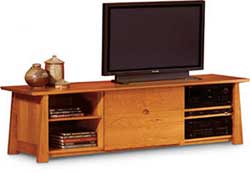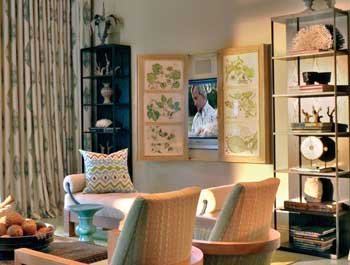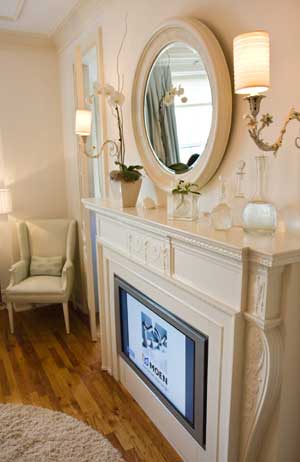
The Neehi 84″ console from Green Design Furniture combines period style with modern elegance.
Remember when a TV set was itself a piece of furniture, its convex screen and all the tubes and wires hidden inside a commode of wood or wood-grained plastic? Then came the armoire that hid a freestanding set behind hinged or retractable doors. The flat screen has been an aesthetic breakthrough. Today’s flat-screen TVs can sit fairly unobtrusively on a piece of furniture or be mounted flush to the wall. But some people don’t want to look at a blank screen, and others find that any TV at all ruins a carefully outfitted period room.

A custom installation from TV Coverups saves early paneling from anachronism. Room by the Workshops of David T. Smith.
Early plasma-TV commercials showed the screen itself as artwork, but Peter Maxson of TV Coverups carried the idea further. Peter started out as a picture framer. After he got a lot of requests to frame flat screens, he devised a way to cover the unit with a custom-framed piece of art, like a painting. The TV is invisible until, at the push of a button, the painting swings up. Natural convection requires no fan, a swivel mount solves any problem of viewing angle, and ceiling reflection and glare from ambient lighting are shielded by a black linen backing on the painting, which, when raised to a 45-degree angle over the set, gives it a theatre-like atmosphere.

Designer Barry Dixon insists on beautiful, easy-to-operate art coverings for flat-screen TVs.
Designer Barry Dixon likes to subtly camouflage a screen with framed prints or paintings that together swing open on side hinges, revealing the screen behind it. He is careful to sufficiently recess the set so that artwork can be mounted on the wall surface. He hides the hinges but keeps the mechanism simple and straightforward so the art assembly can be pulled open and closed very easily; otherwise, he says, laziness takes over and the TV is visible all the time. A 1⁄8″ wooden board is applied to the back of the artwork’s frame to stabilize it and prevent damage from use. Glider tracks should be 1″ to 2″ shorter than the art.
The traditional focal point of the room (before TV) was the fireplace, so why not combine the two? Designer Kelly Giesen used a salvaged fireplace mantel and surround to frame her flat-screen TV. What was unusual is that she put the TV into the firebox rather than above the mantel, which makes it very unobtrusive. The TV, while low, is easy to view from a chair or bed. Depth is a subtle but important installation issue; most flat screens require only 7″ or less, including the mounting brackets. Kelly advises adding a trap door beneath the screen to accommodate DVD players. She places the cable box behind and uses an infrared remote. A fireplace screen covers the set when it is not in use. (Kelly made a beautiful screen for a bedroom, mounting Plexiglas mirror panels behind iron filigree.)

A fireplace screen normally hides the TV when it’s not in use; firebox installations are a favorite trick of designer Kelly Giesen.
Many people opt for a well-designed cabinet, both for ease of setup and eye-level viewing. Pompanoosuc Mills in Vermont points out that their Chelsea TV Lift Cabinet continues to be the most popular design for inconspicuous television storage. Available in cherry, oak, maple, walnut, birch, or bird’s-eye maple, the cabinet features a motorized lift for the TV so that it can be silently lowered into the back of the cabinet when not in use. Available in a range of sizes from 48″ to 78″, the cabinet tucks wires and other components away behind solid-panel doors. Another TV lift comes from Touchstone, whose cabinet is available in many styles and finishes for plasma and LCD flat screens. Noting that a TV in the bedroom is reputed to hamper intimacy, they say their End-of-Bed TV Lift Cabinet nevertheless remains quite popular.
Green Design Furniture brought the armoire into the 21st century with their S2 Petite Media Armoire, handsomely housing smaller TV screens (up to 29″) along with wires, cables, and accessories behind doors that slide back into the cabinet for full viewing access. The high-quality furniture is made of sustainably harvested American black cherry in their workshop in Portland, Maine.
Safety in Installation
Flat-screen televisions, with their enhanced clarity and ease of installation, are wonderful. But it’s important to remember they can be dangerous if not properly installed. They may be thin, but they are heavy, weighing up to 175 pounds., and have a very low center of gravity due to their design. In 2007 there were more than 47,000 furniture-related injuries in the U.S., with over half caused by flat-screen TVs falling or being knocked over by children.
Make sure your flat screen is safely enclosed in a substantial cabinet that children cannot knock over or, if wall-mounted, that brackets are securely bolted and attached to wall studs. Many manufacturers also offer nylon, self-adhering safety straps that secure the television to the mounting mechanism, preventing it from being toppled over by either children or earthquakes.
For TV cabinet sources, see the Products & Services Directory.







